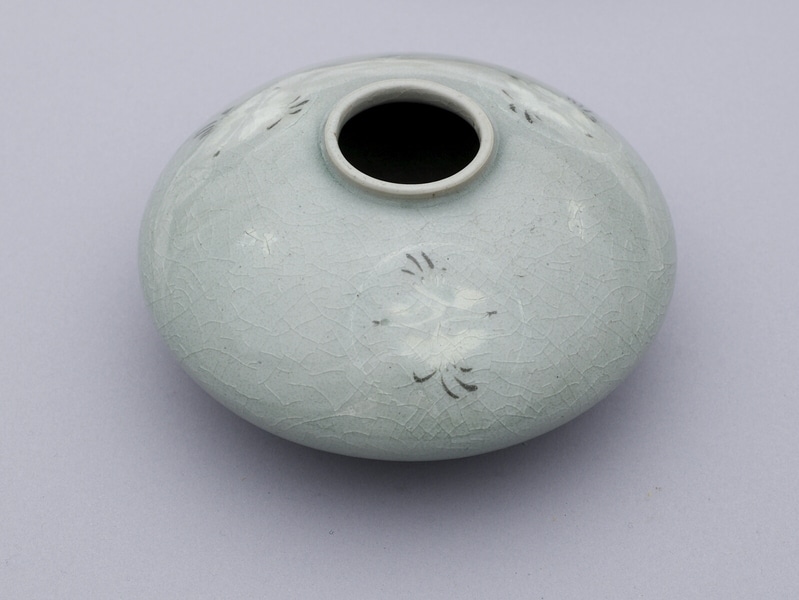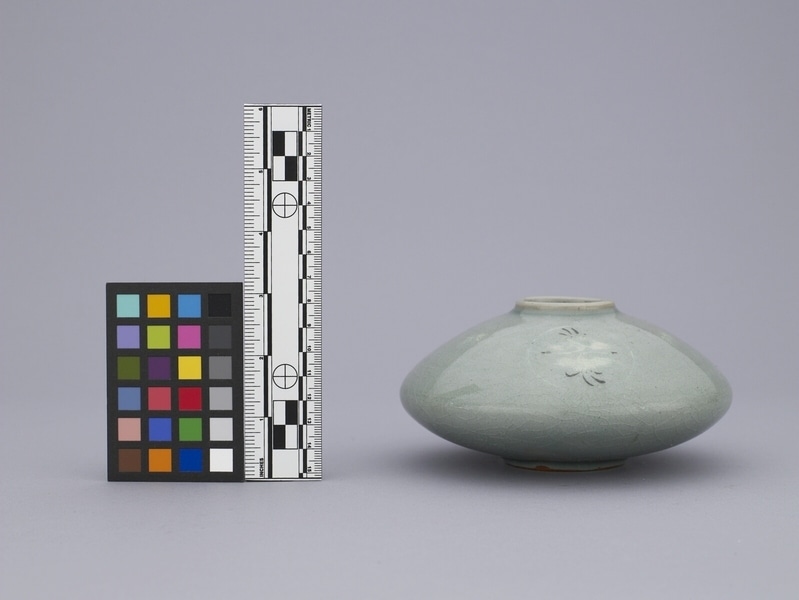Jarlet Item Number: Ed1.150 from the MOA: University of British Columbia



Description
Pale green-gray sanwa kōrai-yaki (三和高麗焼) porcelain bodied jar on single ring foot. Squat compressed spherical shape, lentoid in transverse cross-section, contracting to mouth, with rim turned slightly outward. Orange biscuit exposed around foot. Thick crackled and transparent grey-green glaze. Inlaid on upper surface are three sets of two cranes facing opposite directions, in black and white enclosed by white circle. Between circles are three small white irregular designs.
History Of Use
This jar appears to be the same shape as an old-style oil jar, but without a neck. It is a 19th century copy of a Koryo Dynasty (935-1392) style. In earlier pieces the foot was covered by glaze; in this jar the foot is unglazed.
Narrative
This modern ware known as Sanwa kōrai-yaki (三和高麗焼; Sanwa Goryeo celadon ware) was produced by the Sanwa Goryeo Celadon Ware workshop in Nampo (진남포, 鎭南浦) in current North Korea, by Japanese businessman Tomita Gisaku (富田儀作; 1858–1930) with partial funding from the Japanese colonial government. In 1911, Tomita invited Hamada Yoshinori (1882–1920), who had studied ceramic production at Saga Prefectural Arita Technical School in Kyūshū, Japan, to his workshop in Korea to revive the production of Goryeo celadon. His stepbrother Hamada Yoshikatsu (1895–1980) joined in 1915. They often faithfully copied the intricate inlay technique of the original celadon, but came up with their own designs and used modern techniques of making ceramics. Sanwa kōrai-yaki is an interesting fusion of Korean and Japanese cultures.
Item History
- Made in Nampo, North Korea between 1916 and 1935
- Collected between 1898 and 1935
- Owned by Marion Stephan
- Owned by Charles H. Stephan before January 10, 1977
- Received from Charles H. Stephan (Donor) on January 10, 1977
What
Who
- Culture
- Korean and Japanese
- Previous Owner
- Marion Stephan and Charles H. Stephan
- Received from
- Charles H. Stephan (Donor)
Where
- Holding Institution
- MOA: University of British Columbia
- Made in
- Nampo, North Korea
When
- Creation Date
- between 1916 and 1935
- Collection Date
- between 1898 and 1935
- Ownership Date
- before January 10, 1977
- Acquisition Date
- on January 10, 1977
Other
- Item Classes
- ceramics
- Condition
- good
- Accession Number
- 0352/0216